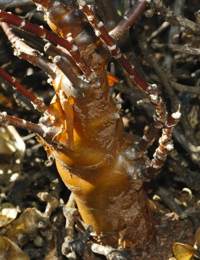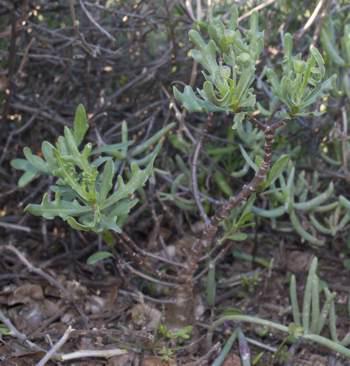Othonna retrofracta
Othonna retrofracta (L.) Jacq.
Family: Asteraceae
Common names: none known
Introduction
Othonna retrofracta, with its bonsai-like appearance, is suitable for water-wise gardens in arid areas.

Description
Description
This deciduous caudiciform (type of plant with a trunk resembling a swollen stem base) is up to 0.3m tall with slender stems arising from a swollen flask-shaped caudex (swollen stem base of a plant) with peeling bark in older specimens. It has numerous thin and twiggy light brown branches with a purple flush when young. The fleshy dark or bluish green leaves are up to 30mm long and about 15mm wide. The plants have a shallow root system and leaves fall off in summer when they become dormant. Flowering time is from May to July and the small flower heads of pale yellow daisy flowers are about 10mm in diameter. Each individual fertile floret produces a one-seeded fruit known as an achene or cypsela.

Conservation Status
Status
Othonna retrofracta is Red Listed as Least Concern.
Distribution and habitat
Distribution description
Othonna retrofracta is restricted to the winter rainfall regions (southern Namibia, and Northern and Western Cape provinces of South Africa) where the amount of rainfall is low. They are often found growing under shrubs.

At the Karoo Desert National Botanical Gardens in Worcester, this species grows in shale and is concentrated in the lower levels of the Robertson Karoo vegetation.
Derivation of name and historical aspects
History
Othonna is derived from the ancient Greek word othonne meaning linen or cloth in reference to the soft texture of the leaves of some species. The specific epithet retrofracta means bent backwards, referring to the branches . Noteworthy members of the genus are the unique rarities O. herrei with its knobbly stems, O. lepidocaulis the scaly othonna and the threatened O. euphorbioides with clusters of forking thorns. The Afrikaans vernacular name for the genus Othonna is bobbejaankool, descriptive of the cabbage-like appearance of the leaves of some species.
The genus Othonna consists of 140 species found from the Western Cape, north to northern Namibia and as far east as northeastern KwaZulu-Natal.
Ecology
Ecology
In its natural environment Othonna retrofracta seedlings usually grow under shrublets known as nurse plants. Seeds will germinate and grow under nurse plants as their leaves and branches protect seedlings from the sun's strong rays. Some O. retrofracta plants grow in the open, as they have outlived the shrublets under which they were nurtured as seedlings. The flowers are possibly pollinated by beetles. At the tip of the achene where the base of the floret is attached, a ring of bristles, known as a pappus (parachute tuft of hairs), assists with seed dispersal by wind.
Uses
Use
Othonna retrofracta has horticultural potential as a pot plant with the caudex borne above the ground being the main attraction for succulent collectors. It can also be used in arid garden rockeries. Other than its gardening potential, no other uses have been recorded.

Growing Othonna retrofracta
Grow
Harvest seed in August and sow in autumn. Use a well-drained sandy loam soil mix and cover the seed lightly with sieved coarse river sand to hold them in place. Othonna retrofracta seeds germinate quite easily, so no special treatment of the seed is needed, and they do well in cultivation. Keep the seed moist and they will germinate after two weeks. By the next autumn, the seedlings should be strong enough to be transplanted in a soil mixture of two parts coarse river sand and one part compost . Propagation by cuttings is unknown. The plant can also be propagated by layering of the lower slender branches, which should be bent down and covered with soil with a stone put on top.
Othonna retrofracta makes an attractive subject in rockeries together with Cotyledon orbiculata (yellow flowers), Gazania krebsiana , Haworthia maxima and Tylecodon paniculatum. This species is resistant to most pests.
References
- Goldblatt, P. & Manning, J. 2000. Cape Plants. A conspectus of the Cape flora of South Africa. Strelitzia 9. National Botanical Institute, Pretoria & Missouri Botanical Garden, Missouri.
- Jackson, W.P.U. 1990. Origins and Meanings of Names of South African Plant Genera . U.C.T. Printing Department, Rondebosch.
- Raimondo, D., Von Staden, L., Foden, W., Victor, J.E., Helme, N.A., Turner, R.C., Kamundi, D.A. & Manyama, P.A. (eds). Red List of South African plants 2009. Strelitzia 25. South African National Biodiversity Institute, Pretoria.
- Rowley, G.D. 1994. Succulent Compositae. A grower's guide to the succulent species of Senecio & Othonna . Strawberry Press, California.
- Vlok, J. & Schutte-Vlok, A. 2010. Plants of the Klein Karoo . Umdaus Press, Hatfield.
Credits
Shireen Harris
Karoo Desert National Botanical Garden
March 2014
Plant Attributes:
Plant Type: Perennial, Succulent
SA Distribution: Northern Cape, Western Cape
Soil type: Sandy, Clay, Loam
Flowering season: Winter
PH: Acid, Neutral
Flower colour: Yellow
Aspect: Full Sun
Gardening skill: Average
Special Features:
Horticultural zones








Rate this article
Article well written and informative
Rate this plant
Is this an interesting plant?
Login to add your Comment
Back to topNot registered yet? Click here to register.